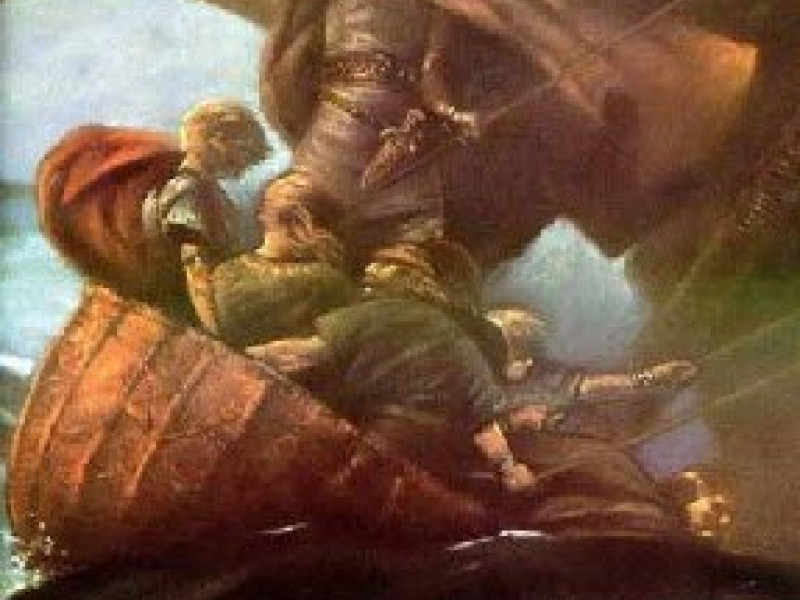Eithne
This tale about Eithne belongs to the Mythological Cycle. The title, Altrom Tig Da Medar or "The Nurture of the Houses of the Two Milk Vessels" is preserved in the manuscript known as the Book of Fermoy.
The story actually began after the Milesians defeated the Tuatha De Danann, where the three sons of Cermait (grandsons of Dagda) were killed in the battle of Tailtiu (see the Coming of the Milesians). Manannán MacLir helped the surviving Danann to retreat from the sight of mortal men to one of the many hidden domains, known as sidh.
Manannán gave feth fiada to the Tuatha De Danann, the power to remain invisible from mortal eyes. The sidh was hidden with magical shrouds, and only a person with feth fiada could come and go from the sidh. Without the feth fiada, a person could not possibly find his way back to his sidh.
Manannán also gave each sidh the Fled Goibniu (Feast of Goibniu) and the Pigs of Manannán. The former were drinks, possibly ales, which kept the Tuatha De Danann young. The latter could be slaughtered, cooked and eaten; but on the morning of the next day, the pigs were alive and ready to be consumed again at the feast.
There were many sidhs around Ireland, and each sidh was ruled by Danann king or queen, or both. The sidh was a magical place, sometimes known as a fairy fort, but it usually contained a palace. At Sith Buidb on Lake Derggert, the sidh was ruled by Bodb Derg, while Midir ruled in Sith Truim. But the most famous otherworldly kingdom in Ireland was the Brug na Boinne, the sidh of Elcmar. Elcmar was husband of Boand or Boann and the foster father of Angus Og. Angus' mother was usually Boann, whom Dagda secretly seduced.
Not long after preparing the new homes for the Tuatha De Danann, Elcmar invited everyone (Danann) to a feast that he had prepared. Manannán advised Angus Og that he should expel his foster father from the Brug; since it was prophesied that Angus would take it. After teaching Angus a powerful spell, Elcmar was forced to abandon his realm, so Angus became the new lord of Brug na Boinne.
Here, Manannán told Angus the secret that there was one God above all others. Manannán told him about the creation of the world and the first man, Adam.
Like all of the Celtic family, Angus Og decided to foster many children of the Tuatha de Danann. Among the fosterlings in his care was Curcog, daughter of Manannán. Around this time, Angus' steward, Dicu, had a wife who was pregnant. She gave birth to a girl named Eithne. She too was brought up in Angus' court and became a dear companion of Curcog.
Eithne grew into a beautiful young woman wooed by many suitors, but problems arose when one suitor named Finnbarr, insulted and upset her. After this insult, she would not eat any food or drink at Angus' table. After seven days of fasting, Angus became seriously concerned. Neither her foster father (Angus) nor his druids knew why she refused all food and drink. Eithne would only drink from what Angus gave her, in a golden goblet filled with milk of his Dun Cow. After this, she ate and drank nothing else. Eithne herself would milk the cow into the golden goblet.
Years and centuries passed and still Eithne's only diet was the milk from her foster father's Dun cow. Hearing of this strange ailment, Manannán sent for her to come to his kingdom at Emain Ablach. Manannán also tried to make a meal for Eithne, but she wouldn't touch his food and drink. When Manannán gave her a drink of milk from a golden goblet, the Danann maiden accepted. The milk came from Manannán's own Speckled Cow.
Manannán then realised the cause of Eithne's diet. When Finnbarr had insulted her, the demon within her body left her, replaced by an angel. This angel would not accept any food of the Tuatha Da Danann, but would accept milk from the dun and speckled cows, because it came from the land of the righteous - India. Eithne was no longer fully Tuatha De Danann.
Eithne returned home to Brug na Boinne, where she continued to live for many centuries, drinking only milk from the Dun Cow.
One day, when it was especially hot, all of the girls in Angus' household went to bathe in the river. At this point, all of her friends disappeared. She could not find Curcog or the other ladies. She had lost her power of feth fiada and she couldn't find her way back home.
In her search for either her friends or her home, she found her way to a church where St Patrick greeted her. There, she learned about Jesus and Christianity. She stayed with Patrick for a number of years.
Angus Og and Curcog were upset with Eithne's disappearance. They searched for her everywhere, until they found Eithne in the church. Both foster father and priest argued about where Eithne belonged. Although Eithne loved and missed her home, her foster father and friends, she chose to stay with the cleric and accept the new faith. Angus and the girl's friends grieved for her when she told them of her decision.
Eithne immediately confessed her sins and was baptised, because she felt that her death was near. She died a couple of weeks later and was given a proper burial. And we are told in the story that her soul went straight to heaven.
Related Information
Sources
Altrom Tig Da Medar (The Nurture of the Houses of the Two Milk Vessels) from the Book of Fermoy.
Related Articles
By Jimmy Joe


